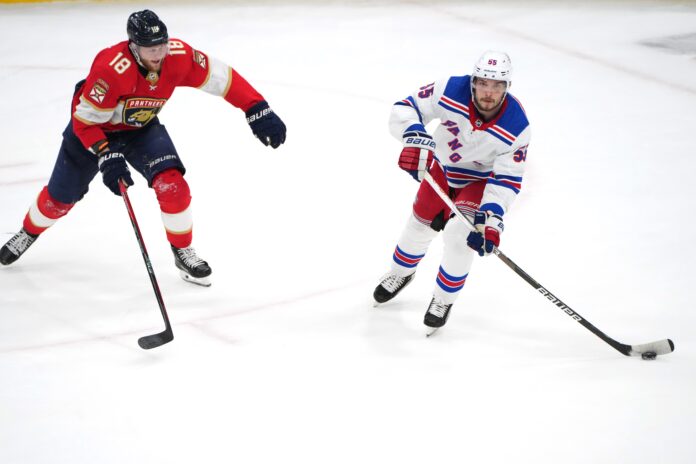One of the big question marks for the Rangers this offseason is Ryan Lindgren’s next contract. As an RFA with arbitration rights, Lindgren is expected to get a significant bump on his $3 million cap hit. One of those heart and soul players, Lindgren provides an element to the blue line that the Rangers are sorely lacking from productive defensemen: A steady defensive presence with some snarl to his game.
But as always, the Rangers must find a balance between Lindgren’s next contract and managing the cap situation to improve upon the team. There are some pretty significant injury concerns with Lindgren, and his style of play rarely ages well. Just look at Marc Staal and Dan Girardi. However Lindgren is just 26 years old, years away from the ages where the Staal and Girardi contracts hamstrung the Rangers.
Lindgren’s next contract could be a doozy
There are two schools of thought with Lindgren’s next contract. Per Evolving-Hockey’s contract estimator, Lindgren is projected to get a 6 year deal at a $4.87 million cap hit. However while that is the “most likely projection,” it comes in at an 18% chance of happening.
Remembering that Lindgren’s qualifying offer is 1 year at $4 million, we can likely eliminate any scenario that comes in under that amount. Based on EH’s projector, we can eliminate the 1, 2, and 3 year contract scenarios, all coming in under $4 million. Some other scenarios:
- 4 years, $4.184 million (13%)
- 5 years, $4.56 million (12%)
- 8 years, $5.465 million (15%)
Lindgren turned 26 in February, so that 8 year deal takes him through his age-33 season. The most likely scenario per EH, the 6 year contract, takes him through his age-31 season.
The other possibility is mirroring Erik Cernak’s 8 years $5.2 million contract in Tampa. Cernak and Lindgren have almost identical offensive production and very similar puck possession numbers. Both struggle to generate offense but are pretty good at limiting quantity of chances against.
Comparing Cernak to Lindgren in terms of style of play and contract makes sense. But we do need to take a step back from their possession numbers and remember the system both have played in. Tampa has had stability and consistency with Jon Cooper. Lindgren has played for 3 coaches in 4 years, coming with learning curves each time.
That said, Lindgren’s numbers took a nosedive this season.
Lindgren’s next contract is risky
No matter which way you slice it, Lindgren’s next contract comes with some pretty significant risk. Injury risk is always there, but it is higher with Lindgren given his style of play. He’s a warrior, we know this, but a warrior is only as good as his ability to stay in the lineup and be productive while doing so.
At just 26 years old, we can only hope that Lindgren’s injury history is a product of being a tad overzealous and he will eventually evolve his game in a more conservative manner while still bringing that same style of play. But that may be wishful thinking.

The other risk is his on-ice play, which took a dive last season, his first under Peter Laviolette. This was his worst statistical season since his rookie season in 2018-2019. Was this an outlier season? Or was this the beginning of a worrying trend? How much of his play was due to Adam Fox’s injury and playing with Erik Gustafsson? How much of the decline was due to the new system and being unable to keep up.
In keeping with the Staal/Girardi comparisons: Both were exposed when Alain Vigneault came to the Rangers due to his hybrid defensive zone system. The Rangers defense played man below the dots, releasing to the forwards and zone above the dots. This is exactly how Laviolette prefers the Rangers to play in the defensive zone.
The difference between Staal/Girardi and Lindgren is both signed their ill-fated deals well into their thirties. Lindgren’s next contract comes at just 26 years of age. There’s a strong argument that his play should rebound back to career norms next season, and his decline may not truly start for another 4-5 seasons.
Still, is Lindgren’s next contract worth that risk? It’s easy to find cases both for and against, but it all comes down to his ask. Ideally, the Rangers get Lindgren in that 3-4 year range, giving them stability on the blue line while mitigating the risk of a long term contract. But he might also be their best trade chip should his demands be well above that mid-range sweet spot.
This is probably the least enviable spot General Manager Chris Drury has been in since the Pavel Buchnevich trade. Does he overreact to the Buch backlash and re-sign Lindgren to a monster deal? Does he learn from his mistake and try to find that sweet spot? Or does he have a clear head, managing all possible scenarios that impact Lindgren’s next contract, making a potentially difficult situation more tenable?




















